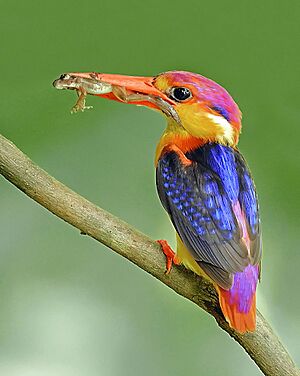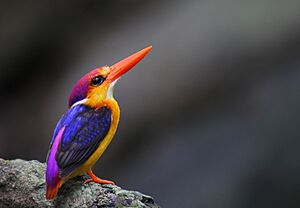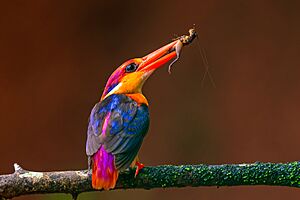Black-backed dwarf kingfisher facts for kids
Quick facts for kids Black-backed dwarf kingfisher |
|
|---|---|
 |
|
| With frog kill from Mangaon, Maharashtra, India | |
| Conservation status | |
| Scientific classification | |
| Genus: |
Ceyx
|
| Species: |
erithaca
|
The black-backed dwarf kingfisher (Ceyx erithaca) is a tiny, colorful bird. It is also known as the three-toed kingfisher. This bird belongs to the Alcedinidae family, which includes all kingfishers. It used to be thought of as the same species as the rufous-backed dwarf kingfisher. Together, they were called the "oriental dwarf kingfisher."
This tropical kingfisher is a bird that sometimes migrates. It lives in parts of the Indian subcontinent and Mainland Southeast Asia. You can find it in lowland forests, usually near streams or ponds. It eats insects, spiders, worms, crabs, fish, frogs, and lizards. It's easy to spot because of its bright red beak, yellow-orange belly, and blue-black back.
Contents
What is the Black-backed Dwarf Kingfisher?
The black-backed dwarf kingfisher is one of the smallest kingfisher species. It's about the size of a medium hummingbird. These birds are about 12.5 to 14 centimeters (5 to 5.5 inches) long. Females usually weigh 14-16 grams, and males are a bit heavier at 14-21.5 grams. Both male and female birds look very similar.
How to Identify This Kingfisher
Both male and female black-backed dwarf kingfishers have:
- A black spot on their forehead.
- Blue and white patches on the sides of their neck.
- A purple-red crown, rump, and tail.
- A dark blue back and wings.
- A white chin and throat.
- Pale yellow-orange underparts.
- Dark brown eyes.
- Red legs, feet, and beak.
Younger birds are not as brightly colored. Their yellow-orange beak has a pale tip. This kingfisher has three toes, which is why it's sometimes called the three-toed kingfisher. Its call is a high-pitched, sharp "tsriet-tsriet." It can also make a soft "tjie-tjie-tjie" sound when flying.
Where Do Black-backed Dwarf Kingfishers Live?
The black-backed dwarf kingfisher lives in forests and wetlands. It is found in parts of the Indian subcontinent and Southeast Asia. Its breeding areas include eastern Bangladesh, northeastern India, Myanmar, southern China, Laos, Cambodia, and Thailand. There's also a separate group in the Western Ghats of western India and in Sri Lanka.
Preferred Habitats
These birds mostly live in deciduous (trees that lose leaves) and evergreen (trees that keep leaves) forests. They can also be found in areas with rubber trees, palms, bamboos, or shrubs. They like to stay near forest streams and ponds. However, their nests are often built far from water. They usually stay close to the ground, flying and perching within 1-2 meters (3-6 feet) of the forest floor. They prefer lowlands that are usually below 1000-1300 meters (3,300-4,300 feet) in height.
Do They Migrate?
Yes, some black-backed dwarf kingfishers migrate. Birds from the northern areas spend winter in the southern parts of their breeding range. They often fly south to peninsular Malaysia from August to September. They return north in March. Many birds are seen migrating at night from August to December in places like Maxwell's Hill and Fraser's Hill in Malaysia. It's not fully known if the northernmost areas of their range are empty during winter.
What Do Black-backed Dwarf Kingfishers Eat?
Black-backed dwarf kingfishers usually hunt alone. They sit on low plants or rocks. Then, they fly out to catch food from the ground or from leaves. They can even take spiders from their webs or catch insects in the air. They can also dive into water to catch prey just below the surface without fully submerging themselves.
Their diet mainly includes:
- Insects like mantises, grasshoppers, flies, water beetles, ants, and mayflies.
- Spiders.
- Worms.
- Small crabs.
- Small fish.
- Small frogs.
- Small lizards.
If they catch larger prey, they take it back to a perch. They hit the prey repeatedly with their beak before swallowing it.
How Do Black-backed Dwarf Kingfishers Breed?
Black-backed dwarf kingfishers lay eggs at different times of the year depending on the location:
- Southwest India: July to September.
- Sri Lanka: February to July.
- Northeast India: April to May.
- Peninsular Malaysia: March to July.
- Sumatra: March.
- Java: December to May.
Nests and Eggs
They build their nests in stream banks, road cuttings, or in soil near the roots of a fallen tree. These nests are often far from water. Both the male and female dig a horizontal tunnel. The tunnel is about 15–100 centimeters (6–39 inches) long and 3.8–4.5 centimeters (1.5–1.8 inches) wide. It ends in a chamber where the eggs are laid. This chamber is about 10–15 centimeters (4–6 inches) wide and 5–7 centimeters (2–3 inches) high. The tunnel and chamber are angled upwards. This helps keep water out and waste material flowing out of the nest.
A pair can dig about 25 centimeters (10 inches) of their burrow in sand in about 40 minutes. They usually lay 3-7 eggs, with about 5 eggs per clutch on average. Eggs are laid in the morning, one day apart.
Incubation and Chicks
Incubation (keeping the eggs warm) starts after the last egg is laid. It lasts for 17–18 days. Both parents incubate the eggs, but the female does more, especially at night. The chicks stay in the nest for 18–20 days. They usually leave the nest in the morning.
Conservation Status
The black-backed dwarf kingfisher is listed as a "Near threatened species" by the IUCN Red List. This means it is not currently in danger of disappearing globally. However, its population is decreasing, and we don't know the exact number of adult birds. It is found in many places, but in the northern parts of its range, it is sometimes hard to find. This might be because it's overlooked or because of its migration patterns. There are special conservation areas across its entire range to help protect it.
Main Threats
The biggest threat to the black-backed dwarf kingfisher is the loss of its forest home. Human activities are clearing forests, which means fewer places for these birds to live and breed.
Other threats that can affect kingfishers and migrating birds include:
- Pollution.
- Ponds and streams drying up.
- People who dislike kingfishers (like some fishermen) or illegal hunting.
- Electric lines.
- Changes in migration and breeding times due to climate change.
- Collisions with buildings and other man-made objects during flight.
- Getting tired, hungry, or dehydrated during migration.
- Erosion of stream banks where they build nests.





